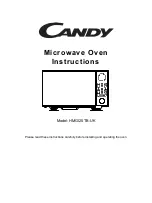
14
EN
What kind of ovenware can be used?
Microwave function
For the microwave function, keep in mind that
microwaves are reflected by metal surfaces.
Glass, china, clay, plastic, and paper let
microwaves pass.
For this reason,
metal pans and dishes or
containers with metal parts or decorations
cannot be used in the microwave
. Glass ware
and clay with
metallic decoration or content
(e.g. lead crystal) cannot be used in microwave
ovens.
The
ideal
materials for use in microwave ovens
are glass, refractory china or clay, or heat
resistant plastic. Very thin, fragile glass or china
should only be used for short period of times (e.g.
heating).
Hot food transmits heat to the dishes which can
become very hot. You should, therefore, always
use an
oven glove!
How to test ovenware you want to use
Put the item you want to use in the oven for 20
seconds at maximum microwave power. After that
time, if it is cold and just slightly warm, it is
suitable to use. However, if it heats up a lot or
causes electric arcing it is not suitable for
microwave use.
Aluminium containers and foil
Pre-cooked food in aluminium containers or in
aluminium foil can be put in the microwave if the
following aspects are respected:
Keep
in
mind
the
manufacturer’s
recommendations written on the packaging.
The aluminium containers cannot be more than
3 cm high or come in contact with the cavity
walls (
minimum distance 3 cm
). Any
aluminium lid or top must be removed.
Put the aluminium container directly on top of
the turntable plate. If you use the grid iron, put
the container on a china plate. Never put the
container directly on the grid iron!
The cooking time is longer because the
microwaves only enter the food from the top. If
you have any doubts, it is best to use only
dishes suitable for microwave use.
Aluminium foil can be used to reflect
microwaves during the defrosting process.
Delicate food, such as poultry or minced meat,
can be protected from excessive heat by
covering the respective extremities/edges.
Important:
aluminium foil cannot come into
contact with the cavity walls since this may
cause electrical arcing.
Lids
We recommend you use glass or plastic lids or
cling film since:
1. This will stop excessive evaporation (mainly
during very long cooking times);
2. The cooking times are shorter;
3. The food does not become dry;
4. The aroma is preserved.
The lid should have holes or openings so that no
pressure develops. Plastic bags must also be
opened. Baby feeding bottles or jars with baby
food and similar containers can only be heated
without their tops / lids otherwise they can burst.
Содержание MWS 22 B
Страница 1: ...User Manual EN Gebrauchsanweisung DE RU MWS 22 BI 1730191...
Страница 40: ...39 RU 43 44 45 45 46 46 47 47 47 47 47 48 49 50 52 52 52 52 54 54 54 55 55 56 56 56 57 57 57 58...
Страница 41: ...40 RU 8...
Страница 42: ...41 RU...
Страница 43: ...42 RU 3...
Страница 44: ...43 RU 3 8 8...
Страница 45: ...44 RU 1 3 4 2 3 4 5...
Страница 46: ...45 RU 1 3 2 1 2 3 150 290 460 650 800 1 3 2...
Страница 47: ...46 RU 1 2 3 2 4...
Страница 48: ...47 RU 1 2 30...
Страница 50: ...49 RU 1 2 3 4 5 6 7 8 9 10 11 12...
Страница 51: ...50 RU 70 C 1 2 3 4 5 6...
Страница 53: ...52 RU 20 3 3 1 2 3 4...
Страница 54: ...53 RU 1 2 2 2 100 C 250 C 3 4 5 1 2 3 4 5...
Страница 55: ...54 RU 2 3 2 3...
Страница 56: ...55 RU...
Страница 57: ...56 RU 1300 850 2450 595 390 320 350 220 280 22 21 6 Green Dot 2002 96 EC WEEE...
Страница 58: ...57 RU 3...
Страница 60: ......
















































